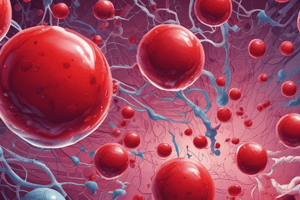Podcast
Questions and Answers
What percentage of whole blood volume is composed of plasma?
What percentage of whole blood volume is composed of plasma?
- 40%
- 55% (correct)
- 65%
- 75%
Which of the following is NOT a component found in blood plasma?
Which of the following is NOT a component found in blood plasma?
- Nutrients
- Neutrophils (correct)
- Albumin
- Electrolytes
In healthy adults, which process allows the fat in bone marrow to be replaced by active marrow when more blood cell production is needed?
In healthy adults, which process allows the fat in bone marrow to be replaced by active marrow when more blood cell production is needed?
- Differentiation
- Extramedullary hematopoiesis
- Fibrosis
- Hematopoiesis (correct)
Which site is primarily associated with the production of blood cells in adults?
Which site is primarily associated with the production of blood cells in adults?
What types of cells do lymphoid stem cells differentiate into?
What types of cells do lymphoid stem cells differentiate into?
What term describes the production of blood cells outside of the bone marrow, such as in the liver or spleen?
What term describes the production of blood cells outside of the bone marrow, such as in the liver or spleen?
What is the primary function of myeloid stem cells?
What is the primary function of myeloid stem cells?
What happens to the proportion of active marrow as people age?
What happens to the proportion of active marrow as people age?
What is primarily produced by the stroma of the marrow?
What is primarily produced by the stroma of the marrow?
Which cell type is responsible for the remodeling of skeletal bone within the stroma?
Which cell type is responsible for the remodeling of skeletal bone within the stroma?
What is the main component of blood that carries oxygen from the lungs?
What is the main component of blood that carries oxygen from the lungs?
Where does hematopoiesis primarily occur in adults?
Where does hematopoiesis primarily occur in adults?
How much volume of blood is typical for men?
How much volume of blood is typical for men?
What is the role of blood in transporting metabolic waste?
What is the role of blood in transporting metabolic waste?
What triggers an increase in blood cell production by the bone marrow?
What triggers an increase in blood cell production by the bone marrow?
Which type of cell is a more differentiated form of B lymphocyte?
Which type of cell is a more differentiated form of B lymphocyte?
Flashcards are hidden until you start studying
Study Notes
Hematologic System Overview
- Comprises blood and production sites: bone marrow and reticuloendothelial system (RES).
- Blood is a unique fluid organ consisting of plasma (55%) and cellular components (7%-9% of volume).
- Plasma contains proteins (albumin, globulin, fibrinogen), electrolytes, waste, and nutrients.
Bone Marrow
- The primary site for hematopoiesis (blood cell formation) in adults, mainly within the pelvis, ribs, vertebrae, and sternum.
- Accounts for 4%-5% of total body weight, contains two types: red (active) and yellow (fatty) marrow.
- Aging replaces active marrow with fat; regeneration is possible when increased blood cell production is needed.
Stem Cells in Bone Marrow
- Contains primitive stem cells that can self-replicate and differentiate into myeloid or lymphoid lineages.
- Lymphoid stem cells produce T or B lymphocytes for immune response.
- Myeloid stem cells develop into erythrocytes, leukocytes, and thrombocytes; defects can lead to blood production issues.
Stroma of Bone Marrow
- Refers to non-hematopoietic tissue, producing colony-stimulating factors essential for hematopoiesis.
- Includes yellow marrow, fibroblasts, osteoclasts, osteoblasts, and endothelial cells.
Cellular Components of Blood
- Composed of erythrocytes (RBCs), leukocytes (WBCs), and thrombocytes (platelets).
- These cellular components make up 40%-45% of blood volume and require continuous replenishment through hematopoiesis.
Daily Blood Cell Production
- Normal adult bone marrow produces approximately:
- 175 billion erythrocytes
- 70 billion neutrophils
- 175 billion platelets daily
- Increased production occurs in response to infections or bleeding.
Blood Composition and Function
- Blood constitutes 7%-9% of body weight; average volumes are 5-6 L for men and 4-5 L for women.
- Functions include transporting oxygen, nutrients, hormones, and antibodies while carrying metabolic waste to elimination sites (lungs, skin, liver, kidneys).
Studying That Suits You
Use AI to generate personalized quizzes and flashcards to suit your learning preferences.




